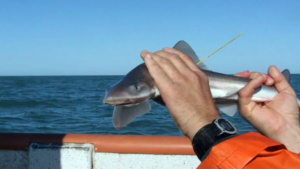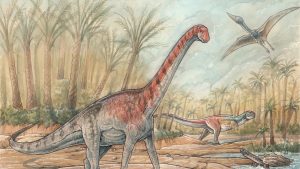The earliest titanosaur in the world was discovered in Patagonia
Paleontologists present in society Ninjatitan zapatai, a new titanosaur from Patagonia that passes into the hall of fame among these colossi that walked on Earth for being the oldest of its group. This animal, about 20 meters in length, lived 140 million years ago, which demonstrates that these gigantic dinosaurs were originated at the beginning of the Cretaceous period.
Emanuel Pujol (CTyS-UNLaM Agency) - Patagonia once again gives an extraordinary record of a titanosaur sauropod. Until now, these gigantic quadrupeds with an antiquity greater than 120 million years were not known, so the discovery of Ninjatitan zapatai has great relevance for the knowledge of the evolutionary history of this group and the Early Cretaceous.
Dr. Pablo Gallina, a researcher at the Fundación Azara in Maimonides University and CONICET, told the CTyS-UNLaM Agency that “the main importance of this fossil, beyond the fact that it is a new species of titanosaur, is that it is the earliest record worldwide for this group”.
"This discovery is also very important for the knowledge of the evolutionary history of sauropods, because the fossil records of the early Cretaceous, in around 140 million years ago, are really very scarce throughout the world," said the lead author of the study published today in the scientific journal Ameghiniana.
Regarding the discovery of Ninjatitan in the Bajada Colorada Formation, southeast of Neuquén, Dr. Juan Ignacio Canale, researcher at the Municipal Museum of Villa El Chocón and CONICET, stated that “in 2014, the technician Jonatan Aroca made the first discovery of a very complete scapula of this animal and, in that moment, we noticed that it was a very important discovery and, thus, we prepared everything to continue working the following year in that geologic level”.
“In the following campaign, three vertebrae and some bones of its hindlimbs appeared; a fragment of the femur and one fibula”, said Canale. And he added: “So, we began the preparation of the materials in the Museum of Villa El Chocón. Until then, we knew that it was a sauropod, but when we made the detailed study of the phylogenetic relationships, of the kinship relationships of this animal with other known species, we realized that it belonged to the group of titanosaurs, hence the importance of this discovery was even greater than we had imagined at the beginning”.
Dr. José Luis Carballido, a researcher at the Egidio Feruglio Museum and CONICET, was specifically focused on the analysis of these phylogenetic relationships. “Doctors Pablo Gallina and Juan Canale already contacted me with the materials prepared and with the finished idea that it was a new species that would most likely be related to titanosaurs, but it was still necessary to resolve where Ninjatitan was located within evolution of the sauropods”.
“A priori, due to the age of this material, 140 million years ago, it could be assumed that it was a form prior to the origin of titanosaurs, because in Patagonia the record of titanosaurs not exceeds far beyond 120 million years before the present”, affirmed Carballido.
But the study revealed that Ninjatitan zapatai was a titanosaur, making it the oldest in the world tens of millions of years apart. "This phylogenetic analysis was carried out with a broad sampling not only of titanosaur forms, but also close and basal forms to the origin of titanosaurs", said the MEF researcher.
Ninjatitan: strike first, strike hard
Ninjatitan represents a new shock, a new blow to knowledge about titanosaurs. And he joins the team of titanosaurs in Patagonia that have made strong appearances in recent times: in 2017, the world's largest titanosaur, Patagotitan mayorum, discovered in Chubut province, was unveiled; and, a few weeks ago, the discovery of another titanosaur was announced in the province of Neuquén that could even exceed it in size.
Ninjatitan thus gives a new strike. However, his name does not have any type of connection to the movements he could perform in life and, of course, this quadruped herbivore did not have the skills to develop a martial art. His name was given in recognition of the Argentine researcher Sebastián Apesteguía, nicknamed "The Ninja" from his beginnings in paleontology.
"Sebastián Apesteguía was who had the idea to visit Bajada Colorada locality in 2010, based on a recommendation from the geologist Hector Leanza, due to the size of the outcrops and its geological characteristics, but that no one had visited in search of fossil vertebrates" , asserted the researcher Canale.
Currently, Pablo Gallina and Juan Canale lead the research in Bajada Colorada, but Dr. Apesteguía always participates in the field work and in the study of the materials that come from there. Canale stressed that "he is a huge paleontologist who has worked a lot in various sites, with a long career in vertebrate paleontology and in the communication of science and, therefore, for us, it seemed very fair to dedicate this species to him."
Meanwhile, the specific name of the species -zapatai-, is dedicated to Rogelio Zapata, a technician at the Villa El Chocón Museum since the mid-90s and participant in all the field work carried out in Bajada Colorada since 2010.
Giants who overcame the Jurassic global extinction
The Bajada Colorada Formation belongs to the beginning of the Cretaceous period, which began after the extinction which marks the end of the Jurassic. “The change of geological periods is always marked by great extinctions, but, specifically, the groups of dinosaurs from which the titanosaurs would arise were not affected by this change; in fact, there are titanosauriforms from the Late Jurassic, such as brachiosaurids or their relatives that crossed that limit without any problem, both in what is now Argentina and in other parts of the world”, explained Gallina paleontologist.
During evolutionary history, the group of sauropods had different moments, different pulses of gigantism, which were not only related to the group of titanosaurs. In this sense, Dr. Gallina exemplified that “there were large animals towards the end of the Jurassic, such as Apatosaurus and Brachiosaurus; and, already in the line of titanosaurs, the pulse with the largest giants occurs towards the middle of the Cretaceous, with species such as Patagotitan, Argentinosaurus or Notocolossus.
In Bajada Colorada, you can see the beginning of the Cretaceous period, a moment in evolutionary history of dinosaurs for which there are not many records. For this reason, the researchers who work there emphasize that every new finding is absolutely novel. "There, we have also found different groups of carnivorous dinosaurs and other groups of herbivorous dinosaurs", mentioned the researcher from the Fundación Azara and CONICET.
Based on the finding of Ninjatitan zapatai and his study published in the scientific journal Ameghiniana under the title “The earliest known titanosaur sauropod dinosaur”, the idea that titanosaurs had a Gondwanic origin is reinforced - in the southern supercontinent made up of what it is currently South America, Africa, India, Australia and Antarctica. Previously, the Gondwanic origin for this group had been raised from theory, but, after this discovery, there is material evidence that supports this idea.



